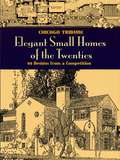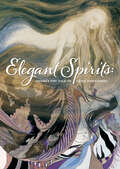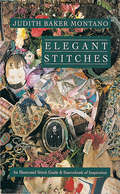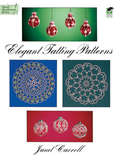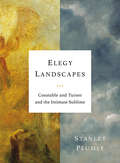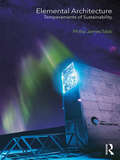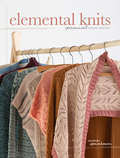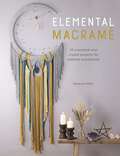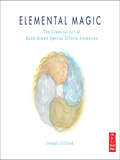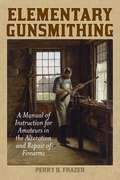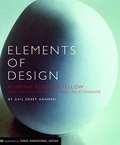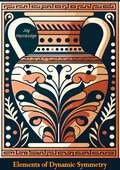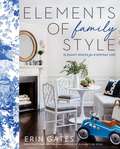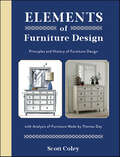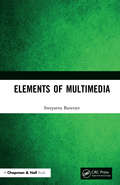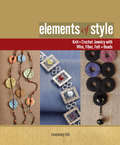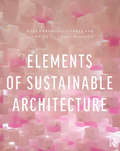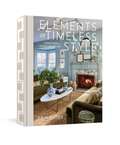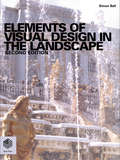- Table View
- List View
Elegant Ribbonwork: 24 Heirloom Projects for Special Occasions
by Helen GibbRespected ribbonwork designer Helen Gibb teaches readers how to add an heirloom touch to any garment or gift in Elegant Ribbonwork. Whether it's ribbon embellishments for wedding garments or a special outfit, readers will learn how to create an upscale look for less time than it takes to find the perfect outfit at a store. This easy-to-follow book includes: Ribbonwork history, which gives readers a solid understanding of this exciting craft Techniques for adding beauty and romance to any special occasion, including anniversaries, luncheons, an evening on the town Special projects tailored to today's brides, featuring popular ribbonwork projects from brides of yesteryear Detailed instructions and hand-drawn illustrations offer readers clarity and encouragement as they create upscale designs.
Elegant Small Homes of the Twenties: 99 Designs from a Competition (Dover Architecture)
by Chicago TribuneIn 1927, the Chicago Tribune sponsored a competition for "trained men of talent, incorporating into the small home ideas of real worth, types of rare charm, and the best possible plans for comfort and convenience." This collection spotlights the challenge's top results, presenting the nineteen prize-winning designs for five- and six-room houses, plus eighty additional sets of the best architectural plans. A new introduction by Daniel D. Reiff, Ph.D., adds interesting detail about the competition and the competitors. These fascinating snapshots of American domestic architecture of the 1920s include glimpses of New England and Southern colonials, Normandy cottages, stately Italianate dwellings, and other styles. Each of the designs features a floor plan and exterior views of the house. Architects, architecture buffs, and historians will prize these authentic renderings of the leading designs in American architecture of nearly a century ago.
Elegant Spirits: Amano's Tale of Genji and Fairies
by Yoshitaka Amano Anri Ito Junichi Imura Kimie ImuraYoshitaka Amano has visualized other worlds of wonder as the artist of the Final Fantasy game series. Now, with Elegant Spirits, our own world's ancient treasures of literature and legend are richly evoked through Amano's paintings and illustrations!Elegant Spirits first contains Amano's adaptation of The Tale of Genji, a psychological exploration of courtly love written a thousand years ago by Lady Murasaki, and often considered to be the earliest novel ever written. The second half of Elegant Spirits is Amano's Fairies, his portrayals of the many magical beings of English and Celtic lore and drama--from brownies and the Seelie Court, to Merlin and Nimue, to Shakespeare's Puck and Titania. The images of Elegant Spirits are accompanied by excerpts of text, poetry, and the stories that accompany these unforgettable figures of the past.
Elegant Stitches: An Illustrated Stitch Guide & Source Book of Inspiration
by Judith Baker MontanoThe renowned fiber artist shares a wealth of inspiration in this illustrated reference guide with 100s of stitches for needleworkers of all skill levels.Judith Baker Montano’s Elegant Stitches features all the step-by-step instructions and illustrations you’ll need to create your own embroidered masterpieces. This volume includes 117 embroidery stitches and more than 130 crazy quilt combination stitches to start your stitching adventure. Judith also offers in-depth instruction on silk ribbon stitches, free-form stitches, composite stitches, and even left-handed stitches.
Elegant Tatting Patterns
by Janet CarrollExperienced tatters in search of especially delicate and beautiful tatting projects need look no further than this outstanding collection of patterns. Master tatter and traditional artist Janet Carroll has compiled 44 designs -- some incorporating threads of two different colors as well as new and advanced techniques. With them, needlecrafters will be able to create an exceptional treasure chest of heirloom-quality doilies, Christmas tree ornaments, and much more.Clear instructions explain how to produce such lovely patterns as the delicate Ellipse, and Exquisite Crowning Touch, dainty edgings for throw pillows, cushion covers, pillow cases, tablecloths, napkins, handkerchiefs, collars, cuffs, and other domestic articles.Sure to add a special touch to linens and other fine fabrics, the lacy symmetry of these superb designs -- clearly photographed for each project -- will challenge intermediate and more advanced tatters.
Elegy Landscapes: Constable And Turner And The Intimate Sublime
by Stanley PlumlyA sweeping look at the lives and work of two important English Romantic painters, from a Los Angeles Times Book Prize–winning author. Renowned poet Stanley Plumly, who has been praised for his “obsessive, intricate, intimate and brilliant” (Washington Post) nonfiction, explores immortality in art through the work of two impressive landscape artists: John Constable and J.M.W. Turner. How is it that this disparate pair will come to be regarded as Britain’s supreme landscape painters, precursors to Impressionism and Modernism? How did each painter’s life influence his work? Almost exact contemporaries, both legendary artists experience a life-changing tragedy—for Constable it is the long illness and death of his wife; for Turner, the death of his singular parent and supporter, his father. Their work will take on new power thereafter: Constable, his Hampstead cloud studies; Turner, his Venetian watercolors and oils. Seeking the transcendent aesthetic awe of the sublime and reeling from their personal anguish, these talented painters portrayed the terrible beauty of the natural world from an intimate, close-up perspective. Plumly studies the paintings against the pull of the artists’ lives, probing how each finds the sublime in different, though inherently connected, worlds. At once a meditation on the difficulties in achieving truly immortal works of art and an exploration of the relationship between artist and artwork, Elegy Landscapes takes a wide-angle look at the philosophy of the sublime.
Elegy for Theory
by D. N. RodowickRhetorically charged debates over theory have divided scholars of the humanities for decades. In Elegy for Theory, D. N. Rodowick steps back from well-rehearsed arguments pro and con to assess why theory has become such a deeply contested concept. Far from lobbying for a return to the "high theory" of the 1970s and 1980s, he calls for a vigorous dialogue on what should constitute a new, ethically inflected philosophy of the humanities. Rodowick develops an ambitiously cross-disciplinary critique of theory as an academic discourse, tracing its historical displacements from ancient concepts of theoria through late modern concepts of the aesthetic and into the twentieth century. The genealogy of theory, he argues, is constituted by two main lines of descent--one that goes back to philosophy and the other rooted instead in the history of positivism and the rise of the empirical sciences. Giving literature, philosophy, and aesthetics their due, Rodowick asserts that the mid-twentieth-century rise of theory within the academy cannot be understood apart from the emergence of cinema and visual studies. To ask the question, "What is cinema?" is to also open up in new ways the broader question of what is art. At a moment when university curriculums are everywhere being driven by scientism and market forces, Elegy for Theory advances a rigorous argument for the importance of the arts and humanities as transformative, self-renewing cultural legacies.
Elemental Architecture: Temperaments of Sustainability
by Phillip James TabbElemental Architecture presents a new and refreshing approach to sustainable architectural practice. Going beyond the standard performance-based and quantitative sustainable measures, it incorporates a broader framework of considerations, including the more poetic and noetic possibilities of environmental design. The book is structured around the ancient Greek and medieval alchemists’ system of the Five Temperaments: fire, earth, air, water, and ether. Phillip James Tabb examines how these elements produce both positive and negative environmental forces which have an impact on architectural design – from drinking water and fresh air to torrential floods and tornados. He shows how responding to or enhancing these forces can help us to create a more sustainable, healthy, and purposeful architecture. To illustrate this, each chapter draws on seminal contemporary works of architecture, from Peter Zumthor’s Bruder-Klaus Field Chapel to Frank Lloyd Wright’s masterpiece at Fallingwater. These examples are accompanied by over a hundred high-quality illustrations. Expanding the discussion of sustainability to include phenomenological as well as qualitative considerations, Elemental Architecture is ideal for students and researchers with an interest in sustainable architecture and architectural theory.
Elemental Knits: A Perennial Knitwear Collection
by Courtney SpainhowerElemental Knits is for women who aspire to be ever stylish, more comfortable, and less wasteful. With knitwear designer Courtney Spainhower, you'll craft an appearance that truly reflects your spirit with a collection of 20 knitting patterns designed to enhance your wardrobe year-round. • Knit with intention, selecting patterns and fibers for their wearablity, versatility, and how they enhance your existing wardrobe. • 20 patterns explore a range of knitting techniques with features suited to each season--texture and cables for autumn, allover patterning for winter, garter and lace for spring, and colorful accents for summer. • Revel in gorgeous details that take these garments and accessories from functional to essential in a way that will have you wearing them year after year. Enrich your hand-knit wardrobe with intentional projects that will act as wardrobe staples for years to come with Elemental Knits.
Elemental Macramé: 20 macramé and crystal projects for balance and beauty
by Rebecca MillarCreate beautiful macrame projects that invoke the sacred elements of Earth, Air, Water, Fire and Spirit. The idea of classical elements' is common to many belief systems including Ancient Greek, Egyptian, Babylonian, Hinduism and Buddhism, as well as Chinese and Japanese philosophies. The five elements of the Pagan religion Wicca represent the five points of the pentagram, a powerful sacred symbol. No matter what your beliefs, paying attention to the forces of nature can bring a greater sense of spirituality and calm to your life, which is equally true of the craft of macrame, which like all handicrafts has proven benefits for wellbeing. This unique and beautiful book celebrates each of the Earth's sacred elements with projects that even beginners to macrame can tackle with ease. In nature, each element has its own specific properties, colours and stones associated with it, which these projects incorporate to dramatic effect. The 20 projects include mooncatchers, wall hangings, home accessories and jewellery, which all draw their inspiration from nature and the elements. Many of the projects have crystals incorporated into them, for the good vibrations and healing energy they bring. You'll also learn how to dip-dye macrame for wonderful ombre effects and work with a variety of different coloured cords to bring beauty and interest to your pieces. Make a tree of life hoop to connect with the earth, a mooncatcher to protect you during sleep, a hanging fruit bowl to feed and nourish you, and a plant hanger to purify your air. Make a necklace to bring out your inner goddess, a crystal suncatcher to capture your fire, or some coasters for your altar candles to sit on. With 20 projects to choose from you will find a whole host of ways to enjoy macrame in a new intentional, spiritual light. Author Rebecca Millar is best known as the creator of Vanir Creations, who has amassed a huge online following for her dreamy macrame hoops and moon catchers. Entirely self-taught, Rebecca now generously shares her secrets in this book, which demystifies the craft with simple explanations of the knots and techniques required.
Elemental Magic , Volume 2: The Technique of Special Effects Animation
by Joseph GillandDesign beautiful, professional-level animated effects with these detailed step-by-step tutorials from former Disney animator and animated effects expert Joseph Gilland. Filled with beautiful, full-color artwork, Elemental Magic, Volume II, breaks down the animated effect process from beginning to end-including booming explosions, gusting winds, magical incantations, and raging fires. He also breaks down the process of effects "clean-up," as well as timing and frame rates. The companion website includes real-time footage of the author lecturing as he animates the drawings from the book. In these videos, he elucidates the entire process from blank page to final animation. See it all come to life like never before. Throughout the book, Joseph refers to and includes examples from his own professional work from feature films such as Lilo & Stitch and Tarzan.
Elemental Magic: The Art of Special Effects Animation
by Joseph GillandCreate amazing animated effects such as fiery blazes, rippling water, and magical transformations. Animation guru Joseph Gilland breaks down the world of special effects animation with clear step-by-step diagrams and explanations on how to create the amazing and compelling images you see on the big screen. 'Elemental Magic' is jam-packed with rich, original illustrations from the author himself which help explain and illuminate the technique, philosophy, and approach behind classical hand drawn animated effects and how to apply these skills to your digital projects.
Elementary Gunsmithing: A Manual of Instruction for Amateurs in the Alteration and Repair of Firearms
by Perry D. FrazerA beginner’s guide to the ins and outs of guncraftsmanship from a professional gunsmith.When it was first published in 1938, Elementary Gunsmithing was one of the few books of the time to address an amateur audience, among more advanced titles. With clear, engaging, and instructional prose, Frazer takes beginner firearm interest to the next level by talking the reader through the fundamentals of gunsmithing, such as what tools are necessary for the craft, how to solder and mount parts, and even how to conduct a fledgling gunsmithing business. He specifically addresses the "young man who likes working at the bench,” and similarly the book reflects the spirit of innovation, resourcefulness, and do-it-yourself work.While the book may not cover contemporary firearms, it offers a grandfatherly, old-school instructional vibe with accurate information about guns up to the 1940s. Frazer focuses on gunsmithing with ordinary hand tools at the work bench, rather than complicated machinery. These helpful tips and information, which are still applicable today, make Elementary Gunsmithing a useful, classic, and historically significant reference for both amateurs and budding gunsmithers keen on building a full-time business.Skyhorse Publishing is proud to publish a broad range of books for hunters and firearms enthusiasts. We publish books about shotguns, rifles, handguns, target shooting, gun collecting, self-defense, archery, ammunition, knives, gunsmithing, gun repair, and wilderness survival. We publish books on deer hunting, big game hunting, small game hunting, wing shooting, turkey hunting, deer stands, duck blinds, bowhunting, wing shooting, hunting dogs, and more. While not every title we publish becomes a New York Times bestseller or a national bestseller, we are committed to publishing books on subjects that are sometimes overlooked by other publishers and to authors whose work might not otherwise find a home.
Elements of Design
by Gail Greet HannahA hands-on book design students and designers alike will welcome. Elements of Design is a tribute to an exceptional teacher and a study of the abstract visual relationships that were her lifelong pursuit. Rowena Reed Kiostellow taught industrial design at Pratt Institute for more than fifty years and the designers she trained-and the designers they're training today-have changed the face of American design. This succinct, instructive, invaluable book reconstructs the series of exercises that led Kostellow's students from the manipulation of simple forms to the creation of complex solutions to difficult design problems. It includes her exercises and commentary along with selected student solutions, and concludes with examples of work from former students who became leaders in the field, including such well-known figures as Tucker Viemeister, Ralph Applebaum, Ted Muehling, and many others.
Elements of Dynamic Symmetry (Dover Art Instruction Ser.)
by Jay HambidgeUnlock the secrets of nature's inherent harmony with Jay Hambidge's seminal work, Elements of Dynamic Symmetry. This groundbreaking book introduces readers to the principles of dynamic symmetry, a system of proportion and design that underlies the natural world and has been used by artists, architects, and designers throughout history to create aesthetically pleasing and harmonious compositions.Jay Hambidge, a pioneer in the study of geometric proportion, presents a comprehensive exploration of dynamic symmetry, tracing its origins and applications across various fields. Through clear explanations, detailed diagrams, and insightful analysis, Hambidge demonstrates how these principles can be applied to achieve balance and beauty in art and design.Elements of Dynamic Symmetry delves into the mathematical foundations of this system, exploring the ratios and relationships that govern dynamic symmetry. Hambidge illustrates how these principles can be found in natural forms, from the spirals of shells to the branching of trees, and how they have been employed in the masterpieces of classical and modern art, from ancient Greek temples to Renaissance paintings.Elements of Dynamic Symmetry is an essential read for artists, architects, designers, and anyone interested in the intersection of art, mathematics, and nature. Hambidge's pioneering work continues to inspire and inform, offering timeless insights into the universal principles of beauty and harmony.Join Jay Hambidge on a journey through the elements of dynamic symmetry and discover how these principles can transform your understanding of design and aesthetics. This classic text remains a cornerstone in the study of proportion and a testament to the enduring power of geometric harmony in the creation of art.
Elements of Family Style: Elegant Spaces for Everyday Life
by Erin GatesNew York Times bestselling author and popular lifestyle blogger Erin Gates shares everything you need to know about designing a beautifully stylish—yet practical and functional—family home through candid advice, inspirational ideas, and lessons learned.Loved by her readers for her chic interior designs and frank and funny revelations about life behind the scenes of her picture-perfect blog, bestselling author and designer Erin Gates presents a new book about how to live stylishly amidst the chaos of daily family life. Throughout her career designing homes for families of all kinds all over the country, Erin has always maintained that living with children and pets does not mean that you have to forego nice things. This uniquely personal and practical guide will explain how to create a home that makes you proud and reflects your own style while also being durable, safe, and comfortable for children. It focuses on the spaces families share, those that are dedicated to the kids, and the oft-forgotten retreats for parents. Erin combines honest design advice and gorgeous inspirational photographs with engaging and intimate personal essays about life lessons learned the hard way while struggling with infertility and becoming a mother, managing a business, overseeing her own home renovation, and finding time for her marriage. She&’ll share how to store toys so that shared spaces don&’t look like a kindergarten, the expensive-looking fabrics that will stand up to a marauding toddler with sticky hands, nursery looks that go beyond blue and pink, and furniture that does not have to be stored during the baby-proofing years. She also showcases the work of other designers she loves who surround parents, children, and their pets with comfort and beauty. Like a best friend who has a knack for style and a taste for fun, Erin opens her front door and invites you into her life and all of its beautiful imperfection.
Elements of Furniture Design
by Scott ColeyA comprehensive look at the history, elements of construction, and all the steps in furniture design from an expert in the industry. Elements of Furniture Design is a resource of information gathered from 30 years of working as a professional furniture designer. These elements of design are essential, and there is no other resource where they are available in one place. The reader will gain a comprehensive knowledge of how furniture is designed, and can use this information to create new and exciting design concepts. This knowledge is provided in four sections: • A brief history and quick designer references (woods, veneers, wood joinery, comfort, architectural references, and drawing tools) • Illustrating furniture construction • Historic ornament used on furniture (molding, turning, carving) • The typical design process with a new client The work of cabinetmaker Thomas Day (a free man of color in the South in the mid-1800s) is used to tie the story together, and the reader will learn trade secrets of furniture design that have been lost to outsourcing and offshore manufacture.
Elements of Japanese Design
by Boye Lafayette De MenteElements of Japanese Design introduces 80 key concepts in Japanese design in a readable and accessible short-entry format. Including a brief explanation and examples of every aspect of Japanese design-from Wah (Harmony) to Kaizen (Continuous Improvement), from Mushin (the Empty Mind) to Mujo (Incompleteness).
Elements of Multimedia
by Sreeparna BanerjeeElements of Multimedia presents a systematic introduction and integrated overview of the state-of-the-art innovations that make Multimedia a rapidly evolving technology in the digital domain. This book is also an invaluable resource for applied researchers. Some of the salient features of the book include: <P><P> <li>Overview of recent additions to multimedia like New Media, Digital Media, Social Media and Mobile Media. <li>This book provides a starting point for researchers wishing to pursue research in Multimedia. <li>Discussions on advances in Web Technology, particularly Web 2.0, as well as Multimedia Applications. <li>Detailed descriptions on different Multimedia elements like text, graphics, images, audio, video and animation. <li>Introduction to the concepts of data compression. <li>Various aspects of multimedia presentations. <li>Multimedia storage hardware. <li>Databases for Multimedia data storage and indexing schemes for accessing Multimedia data. <li>Multimedia communications and networking issues. <P><P>Each chapter ends with a review of the topics covered and a set of review questions to enable the student to go back to the chapter and recapitulate the subject matter. Answers to the Multiple-Choice Questions (MCQ) are provided at the end of the book. Solutions of problems are also provided.
Elements of Performance: A Guide for Performers in Dance, Theatre and Opera (Choreography and Dance Studies Series)
by Pauline KonerFirst Published in 1992. Routledge is an imprint of Taylor & Francis, an informa company.
Elements of Style
by Erin GatesFrom the rising-star designer and author of the hit blog, Elements of Style, a full-color, fully illustrated book packed with honest advice, inspiration, ideas, and lessons learned about designing a home that reflects your personality and style.Elements of Style is a uniquely personal and practical decorating guide that shows how designing a home can be an outlet of personal expression and an exercise in self-discovery. Drawing on her ten years of experience in the interior design industry, Erin combines honest design advice and gorgeous professional photographs and illustrations with personal essays about the lessons she has learned while designing her own home and her own life--the first being: none of our homes or lives is perfect. Like a funny best friend, she reveals the disasters she confronted in her own kitchen renovation, her struggles with anorexia, her epic fight with her husband over a Lucite table, and her secrets for starting a successful blog. Organized by rooms in the house, Elements of Style invites readers into Erin's own home as well as homes she has designed for clients. Fresh, modern, and colorful, it is brimming glamour and style as well as advice on practical matters from choosing kitchen counter materials to dressing a bed with pillows, picking a sofa, and decorating a nursery without cartoon characters. You'll also find a charming foreword by Erin's husband, Andrew, and an extensive Resource and Shopping Guide that provides an indispensable a roadmap for anyone embarking on their first serious home decorating adventure. With Erin's help, you can finally make your house your home.
Elements of Style: Creating Jewelry with Wire, Fiber, Felt, and Beads
by Rosemary HillMake wearable pieces of art with the clever techniques and unique designs ideas in Elements of Style. It's all about the mix in this creative approach to making fabulous jewelry.These seventeen modern wire, bead, and fiber jewelry designs using knit, crochet, and felting techniques will appeal to jewelry makers of all levels. Get familiar with materials, tools, and techniques-crafters will use basic wireworking, beading, knitting and crochet for most projects. Crochet or knit silver or copper wire and mix it with contrasting beads and metal findings. Knit or crochet thin textured yarns, such as linen, hemp, or unique fiber blends to create wire-framed beads, fiber hoop earrings, or an elegant scarf necklace. Or use a variety of felting techniques to create wire-caged beads, wide-cuff bracelets, rope necklaces, and more. Special technique sidebars and tip boxes throughout the book ensure success with every project. The delicate scale of projects makes them a great way to use up small amounts of fiber, beads, and wire from your stash. With projects ranging from a Felted Rings Cuff and Framed Beads Bracelet to a Knitted Tube Necklace, you'll have lots of clever designs to choose from featuring a variety of beads and fibers.
Elements of Sustainable Architecture
by Rosa Urbano Gutiérrez Laura de la Plaza HidalgoFor sustainable architecture to become a reality, the way we design buildings needs to change. Many architects are concerned that sustainable technologies may interfere with a building’s aesthetic appearance, and so these are often ‘added on’ once the design process is complete. Elements of Sustainable Architecture solves this dilemma by helping students to develop the design skills they need to create sustainable buildings – ensuring that ecological considerations are applied throughout the design process. Restoring the primacy of aesthetics and creativity to sustainable design, the book focuses on strategies that have the greatest impact on building design. It also shows the influence of sustainability considerations on choices about aspects such as composition, form, space, tectonics, materials, colour, textures, proportion and position. Specifically designed to offer a new way of understanding architecture, the book: introduces students to the basic principles and methods of sustainable design; features current examples and inspiring case studies to support learning step by step; presents information in a visually appealing, intuitive, easy-to-understand way; includes over 500 high-quality colour diagrams, drawings, sketches and photographs. A clear, visual introduction to creating aesthetically beautiful and sustainable buildings, this is essential reading for students in sustainable architecture courses.
Elements of Timeless Style: Creating a Forever Home
by Erin GatesFrom the New York Times bestselling author of Elements of Style, Erin Gates, a stunningly inspirational and personal book filled with crisp takeaway advice for anyone designing their &“forever&” home—or any space they want to feel like a forever home.Erin Gates is beloved for her unique blend of American approachability and elegance. The author of the bestselling classic Elements of Style, Erin now broadens her lens by looking at nine homes to learn how each homeowner approached the space to make it livable, versatile, and beautiful. The first home in the book is hers—and, in true Erin fashion, she shares her process, fumbles and all. Your home is your sanctuary—a safe space that nurtures your emotional, physical, and mental well-being. In Elements of Timeless Style, Erin shares her decades of expertise to guide you in making thoughtful choices, big and small, that enhance your living space. She empowers you to make confident investments, so you and your home evolve together. Organized by the nine home projects, Erin anticipates and answers every remodeling and decorating question, from the mundane to the material. Each home showcases a unique approach, shunning cookie-cutter solutions in favor of personalized, imaginative designs that celebrate individuality and personal taste. With insights on budgeting, decision-making, and design phases, Elements of Timeless Style is for anyone who wants a thought partner in design, whether you&’re overhauling your entire space or making intentional, gradual changes.
Elements of Visual Design in the Landscape
by Simon BellPublic concern about the landscape, in particular its appearance, is increasing all the time. For those charged with managing, developing or conserving a wide range of landscapes it is a major task to take visual aspects into account. Elements of Visual Design in the Landsacpe presents a vocabulary of visual design, structured in a logical and easy to follow sequence. It is profusely illustrated using both abstract and real examples taken from a wide range of international locations together with cross referencing between related principles and case studies demonstrating how the principles can be applied in practice. The visual aspects of design have often been treated as 'cosmetic' and therefore not meriting attention or purely subjective and therefore open to personal preference. Few attempts have been made to explain how we see the landscape in any rational and structured way, and to demonstrate how visually creative design and management can be undertaken. This book aims to fill that gap.

